The NVIDIA GeForce GTX 1070 Ti Founders Edition Review: GP104 Comes in Threes
by Nate Oh on November 2, 2017 9:00 AM EST- Posted in
- GPUs
- GeForce
- NVIDIA
- Pascal
- GTX 1070 Ti
Power, Temperature, & Noise
As always, we'll take a look at inter-related metrics of power, temperature and noise. Particularly with noise, these factors can render unwanted even a decently-performing card, a situation that usually goes hand-in-hand with high power consumption and heat output. As this is a new GPU, we will quickly review the GeForce GTX 1070 Ti's stock voltages as well.
| GeForce Video Card Voltages | |||||
| GTX 1070 Ti Boost | GTX 1070 Boost | GTX 1070 Ti Idle | GTX 1070 Idle | ||
| 1.062v | 1.062v | 0.65v | 0.625v | ||
With the exception of a slightly higher idle voltage, everything remains the same in comparison to the GTX 1080 and 1070. The idle voltage actually matches the GTX 1080 Ti idle voltage, but isn't particularly significant as it seems to vary from card to card. In comparison to previous generations, these voltages are exceptionally lower because of the FinFET process used, something we went over in detail in our GTX 1080 and 1070 Founders Edition review. As we said then, the 16nm FinFET process requires said low voltages as opposed to previous planar nodes, so this can be limiting in scenarios where a lot of power and voltage are needed, i.e. high clockspeeds and overclocking.
Fortunately for NVIDIA, GP104 has always been able to clock exceptionally high, at least the good chips, so with a slight knock on efficiency in the form of a 180W TDP, the GTX 1070 Ti Founders Edition is also able to clock exceptionally high, and then a little more. I also suspect the maturity of TSMC's 16nm FinFET process is playing a part here, but the card's higher TDP and NVIDIA's clockspeed choices make it hard to validate that point.
| GeForce Video Card Average Clockspeeds | |||
| Game | GTX 1070 Ti | GTX 1070 | |
| Max Boost Clock |
1898MHz
|
1898MHz
|
|
| Battlefield 1 |
1826MHz
|
1797MHz
|
|
| Ashes: Escalation |
1838MHz
|
1796MHz
|
|
| DOOM |
1856MHz
|
1780MHz
|
|
| Ghost Recon Wildlands |
1840MHz
|
1807MHz
|
|
| Dawn of War III |
1848MHz
|
1807MHz
|
|
| Deus Ex: Mankind Divided |
1860MHz
|
1803MHz
|
|
| Grand Theft Auto V |
1865MHz
|
1839MHz
|
|
| F1 2016 |
1840MHz
|
1825MHz
|
|
| Total War: Warhammer |
1832MHz
|
1785MHz
|
|
The end result is that the GTX 1070 Ti is amusingly able to reverse the GeForce Founders Edition trend of decreased clocks with higher-performing models; that is, as we reviewed them, the GTX 1080 Ti maintained lower clockspeeds than the GTX 1080, which in turn had lower average clockspeeds than the vapor-chamberless GTX 1070, which had lower clockspeeds than the GTX 1060. Typically, that was the case due to extra hardware units, and thus extra power consumption and heat. But as we see in the GTX 1070 Ti Founders Edition, despite the extra SMs and such, the vapor chamber and higher TDP work well in allowing the GTX 1070 Ti to boost high. In fact, higher than the GTX 1070 FE across the board, but in relative terms the clockspeeds only come out to about 2% faster on average than the GTX 1070 FE. In relation to the 1683MHz boost specification, the GTX 1070 Ti on average clocks nearly 10% above that in these games, though that is something we've already seen with previous Pascal cards. And we can also start to see the line of thinking that leads to framing the GTX 1070 Ti as an "overclocking monster."
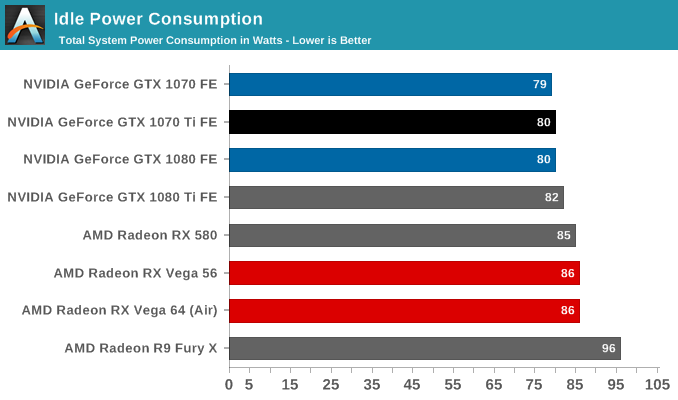


As those higher clockspeeds bear out in power, heat, and noise, there are no surprises here with the GTX 1070 Ti Founders Edition. We've already seen several variations in the aforementioned Founders Edition cards. Here, the blower and vapor chamber are more than adequate for what the card can put out, and in turn lessening the work (and noise) the fan needs to do.
Given the higher 180W TDP, the card can also be closer to GTX 1080 levels of power consumption if need be, though with measurements at the wall, the accuracy of quantification is less than ideal. But in any case, the GTX 1070 Ti has no real necessity to be a power-sipper at this performance range, for which the crown has already gone to the GTX 1070. On top of that, drops in power efficiency will likely not be noticable when compared to its RX Vega competition, or even just against RX Vega 56, whose Battlefield 1 power consumption at the wall is closer to the GTX 1080 Ti FE than the GTX 1080, let alone the GTX 1070 Ti FE.
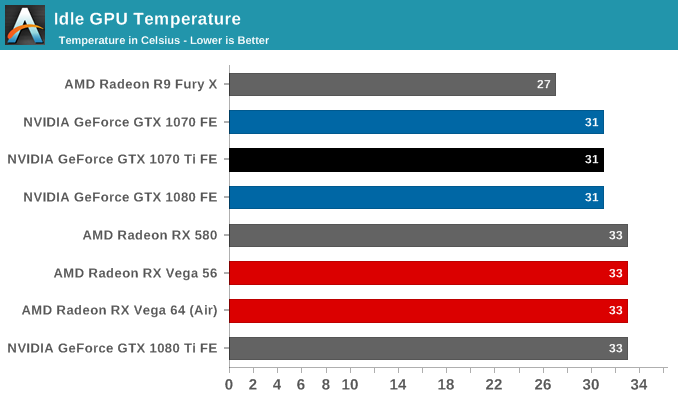
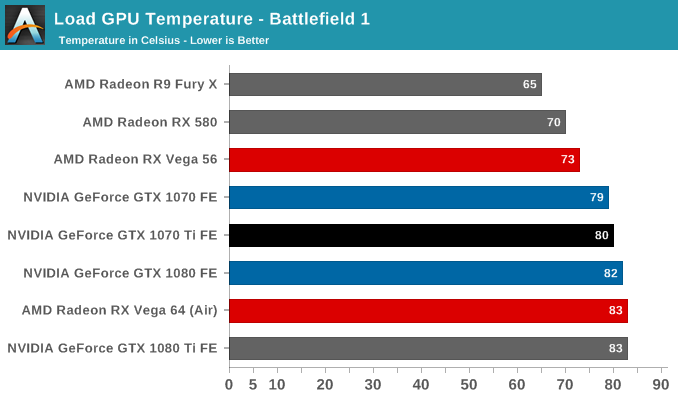
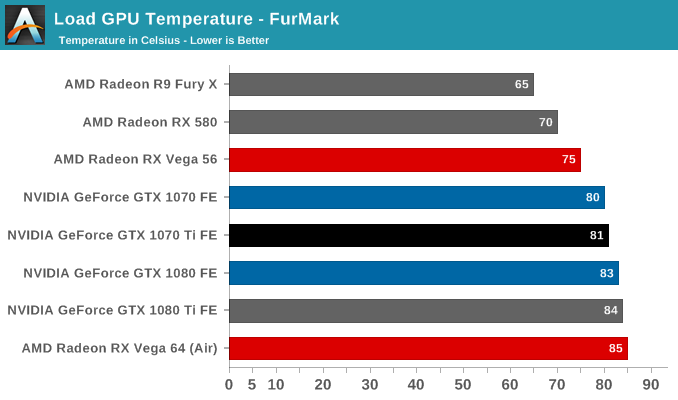
As far as heat and noise go, the GTX 1070 Ti FE has the same 83C throttle point as the GTX 1080 and 1070 FEs, and will approach there under load, though with the GTX 1080's vapor chamber cooler, is kept a little cooler. This follows in fanspeeds and noise as well, and particularly in the eternal power-virus that is Furmark. So for both temperature and noise, the GTX 1070 Ti FE sits right in between the GTX 1080 and 1070 FEs.
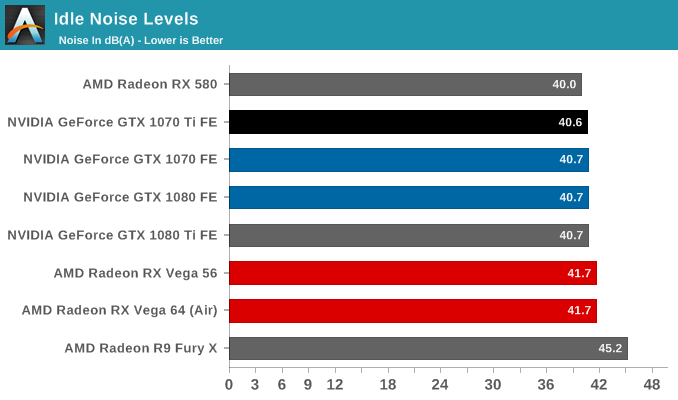
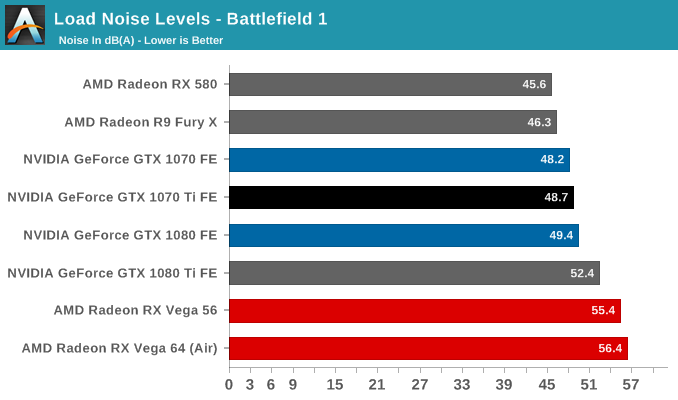
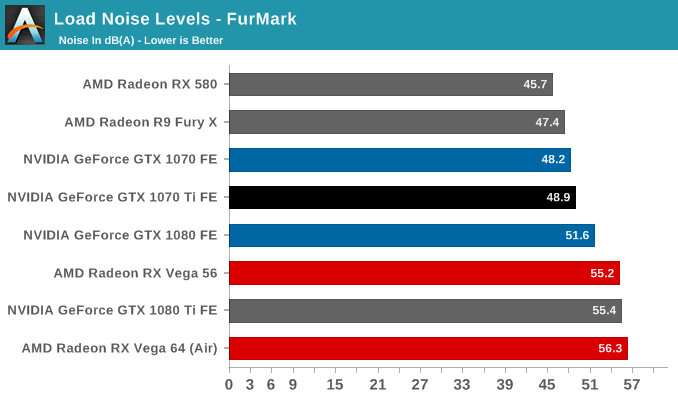










78 Comments
View All Comments
Morawka - Thursday, November 2, 2017 - link
Nvidia has a ton of flawless GP104 dies stockpiled and the 1080's are selling because they use GDDR5X memory which is slower for mining. This makes perfect sense if what i describe is true. You get rid of all those extra GP104 dies by paring it with lower latency GDDR5. This card was built with miners in mind, particularly with the GDDR5 implementation. .Morawka - Thursday, November 2, 2017 - link
**Miners are not buying gtx 1080 due to slower GDDR5X. Nvidia re-engineers 1080 for better mining performance.CiccioB - Friday, November 3, 2017 - link
Your logic is somehow faulty.The chip mounted on this 1070Ti is far for allowing them to recycle any stockpile of defective chips: it requires the chip to be fully functional but a single SM (5% of the chip).
nvidia could sell much more faulty chips with the original 1070 card at whatever price seen the miners do ask for them as if they were slices of bread.
What nvidia is doing here is just creating a card that on benchmarks runs better than the concurrent card using slightly faulty chips (or disabling them on purpose), selling the card at higher price than the 1070 and just a little below the 1080.
If nvidia had lots of defective GP104 to get rid they could just have created a 1060Ti. But that would be a useless card that would compete with none but 1070, that is they would lose money by doing do.
Kevin G - Thursday, November 2, 2017 - link
AMD has had a long road to get everything integrated together but things finally seem to be falling into place with a common on-die fabric. Their previous SoC designs still had a proprietary bus for the on-die GPU. Infinity fabric is also being pushed to the GPU team for scaling up their designs as well. Long term, I would predict some GPUs falling into the same sockets as their processors for HPC workloads. This long term idea probably won't happen until they use multiple GPU dies on a single interposer.AMD had to do all this work while the company was in in the red but it looks like the results are paying off with a competitive CPU architecture again and some gains on the GPU side too. They're back in the black but I don't think AMD can afford to allocate the resources to a pure enterprise compute project. They won't ignore that market, but the base architecture will stem from the gaming side.
cwolf78 - Thursday, November 2, 2017 - link
I agree it's too expensive as well. I think this should have been set at $399. The sad part is that it's going to be impossible to find at even the MSRP in short order. I'm content to stick with my overclocked GTX 970 until this mining fad is over - or until the current crypto formats become resistant to GPU-based mining.extide - Thursday, November 2, 2017 - link
Honestly, I see nvidia phasing out the vanilla 1070 over the next few months and then sliding the 1070 Ti into the $399 price slot.CiccioB - Thursday, November 2, 2017 - link
This means nvidia is not going to sell GP104 with more than a single SM broken... which is a great waste of money for them. So no, they will keep the old card in stock and this Ti version, in fact, will be rarely found, as it is created just for looking better on charts against a no available card from the concurrent. So it does not need to be produced in mass (and probably cutting that single SM on purpose on a perfectly good die, as I do not think that the availability of GP104 with 1 bad SM can be higher that with 5 bad SM).zepi - Thursday, November 2, 2017 - link
Such chips could still be used sa GTX1070M, so there is still a product where they can be used.Not to mention that at this point of the GP104 manufacturing they should be having very nice yields already.
DanNeely - Thursday, November 2, 2017 - link
There's also the Quadro P4000 which at 14 SM enabled is the lowest end GP104 part on the market.But yeah the 1070 TI only having a single disabled SM almost certainly speaks to much higher yields since the product first launched a year and a half ago.
znd125 - Thursday, November 2, 2017 - link
Great writing and review.